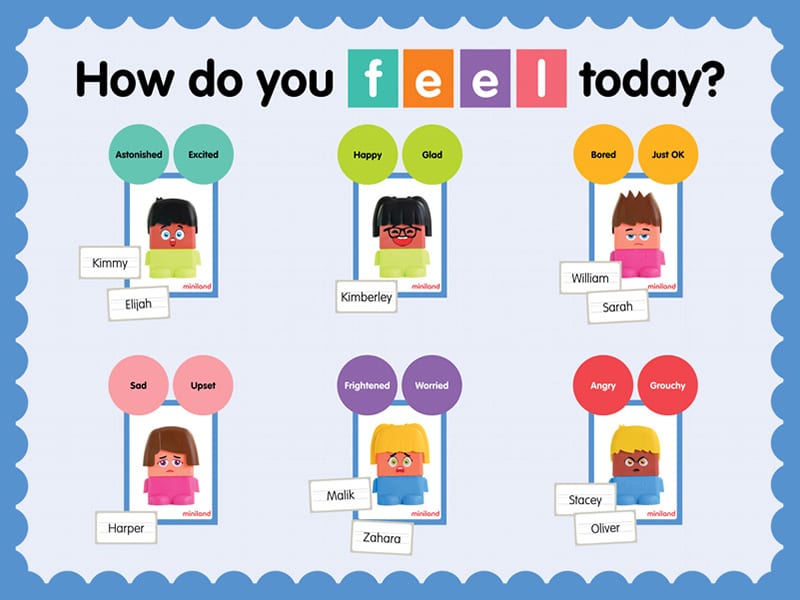Social-emotional skills like identifying and regulating feelings, kindness, sharing, and empathy are all skills that kids learn in early childhood, and they have a huge impact on later success. In fact, one study found that the social-emotional skills that kids display in kindergarten correlate with success in early adulthood, making SEL activities worth including in every classroom. Here are some of our favorite social-emotional learning activities to use with your preschool and kindergarten students.
New to SEL? Start here: What is Social Emotional Learning (SEL)?
Jump to:
SEL Activities for Self-Awareness and Self-Management
These SEL activities are all about learning to recognize, understand, and manage feelings, emotions, and behaviors. This is a major SEL focus for preschool and kindergarten, helping kids learn to understand how they’re feeling, why they’re feeling that way, and how to cope with those big feelings. When you teach self-awareness and self-management at this age, kids get better at responding to challenging situations, now and in the future. Try some of these activities with your preschoolers and kindergartners.
1. Post a feelings chart
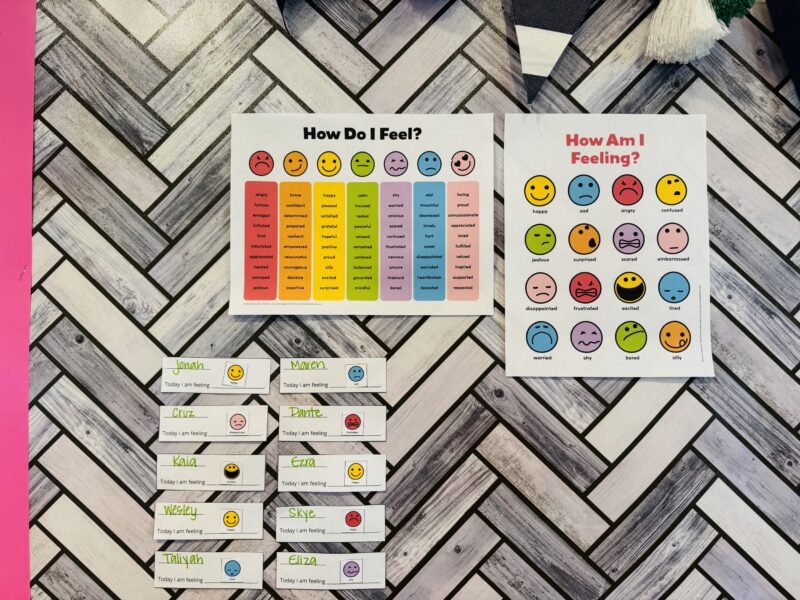
Start your day with a morning meeting. When you talk about the weather and schedule for the day, also include a few minutes to talk about how everyone is feeling or explore a specific emotion in more detail. Kids can also refer to these charts when they’re struggling.
2. Use real faces to learn emotions
Create a slideshow with faces of your students showing different emotions or of photos of kids making feelings faces. Kids will get a kick out of seeing their classmates making different faces, but it also gives them practice recognizing emotion in real humans.
3. Make affirmation bracelets
Set out cups of colored beads. In front of each cup of beads, add a sticky note with a positive affirmation. For example, red may be “I can do this,” orange is “I am smart,” yellow “I am special.” Have each student make a rainbow bracelet with pipe cleaners and beads. Remind them to use their positive affirmations throughout the day when they touch the red bead and tell themselves they can do it!
4. Teach feelings vocabulary words
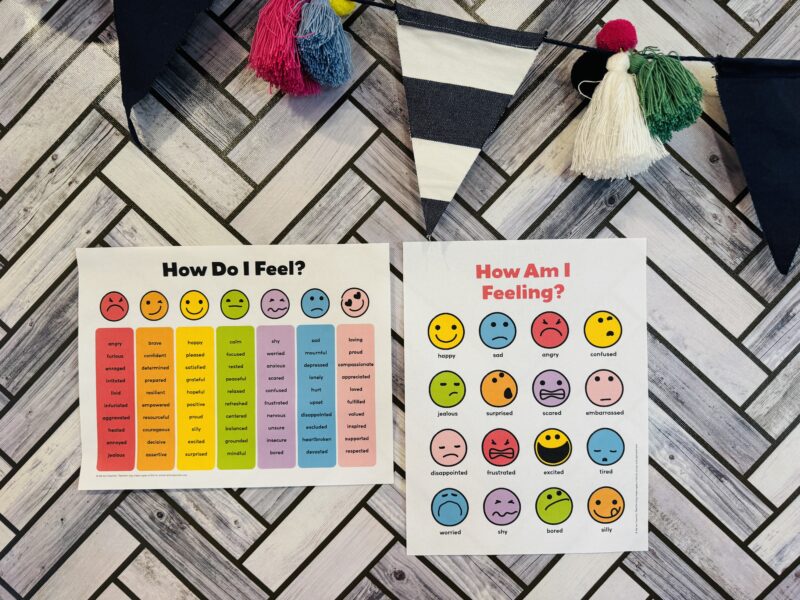
Talking about big feelings takes a big vocabulary! Our free printable chart is a terrific tool for helping kids find the words they need to make their feelings clear (to themselves and others). You can also use the words to create a word wall in your calm-down corner.
5. Sort emotions pictures
Print out pictures of emotions, either the basic emotions or the basics plus more (anxious, disgusted, afraid, etc.). Print images that could go with each emotion. You could print a picture of a spider to go with “afraid” or a birthday cake to go with “happy.” Have students sort the pictures with the emotions. How does each picture make them feel? (Note that not all students may have the same reaction to each picture.)
6. Play a game of musical feelings
Draw feelings faces on paper plates and lay them out on the ground in a circle. Play music and have students move around the circle until the music stops. Students look at the card closest to them and hold a pose that demonstrates that feeling until the music starts again.
7. Hang an emotions bulletin board

Teach emotions using our free printable bulletin board set! Kids can move their names to the appropriate place on the board to share how they’re feeling each day. This can be easier for some kids than talking out loud, especially in front of the whole class.
8. Make a feelings collage
Collect magazines or old books for this group project. Start by choosing one feeling, like “happy.” Ask kids to tear or cut out images from the materials that represent that emotion for them. Write the emotion in the middle of a piece of chart paper, and attach the pictures they find to create a collage. Continue with other emotions to make a whole set of collage posters. (This is another activity that shows that people can have different emotions about the same thing. For instance, one student might say pickles make them happy, while another finds them disgusting.)
9. Encourage “I” statements
Encourage students to be mindful about how they’re feeling by helping them practice how to articulate their thoughts without lashing out at others. Give them starters such as “I feel angry when …,” “I feel happy when …,” “I feel frustrated when …,” etc. Once they are able to articulate their feelings, help them strategize ways to handle those emotions.
10. Match emotion cards
Print two sets of our free “Today I Feel …” cards. Cut them apart, mix them up, and lay them face down on the table or floor. Kids take turns turning over two cards to see if they match. If they do, the player keeps the cards. If not, the next player takes a turn. Be sure to name each emotion as you turn it over to give kids practice recognizing feelings.
11. Make emotion masks
Make emotion masks using paper plates, markers, and other art supplies. Then, have kids sit in a circle, and invite one student into the middle. They call out an emotion, and the other students hold up the appropriate masks to match. Verify everyone has chosen the correct mask, then pick another student for the next round.
12. Paint gratitude rocks
Use river rocks and paint markers, and ask students to paint the rocks to express what they’re thankful for or something they care about. Create a jar or garden display using their finished rocks, and encourage others to check out the display and add their own rocks to the collection!
13. Teach the characteristics of feelings
This easy (and free!) lesson plan helps kids recognize what feelings and emotions look like, both in themselves and in others. Kids will have a great time adding play dough features to their face work mat to represent the different emotions.
14. Play with a feelings tower
Pick up a set of colorful Jenga-style blocks and assign an emotion to each color (red = happy, blue = sad, orange = angry, etc.). As kids pull the blocks to play the game, they name something that evokes that feeling for them. For example, if a student pulls a blue block, they might say that they’re sad when their grandparents go home after a visit. SEL activities like this not only help kids identify feelings, they help them become more comfortable talking about them with others.
15. Try a Zones of Regulation activity
This simple concept assigns colors to emotions: red (angry), orange (overwhelmed, frustrated), yellow (worried, anxious, confused), blue (sad, disappointed), and green (calm, content, happy). Once students have identified which zone they’re in, they can learn the appropriate strategies to manage their feelings.
Try it: Zones of Regulation Activities
16. Teach calming breathing techniques
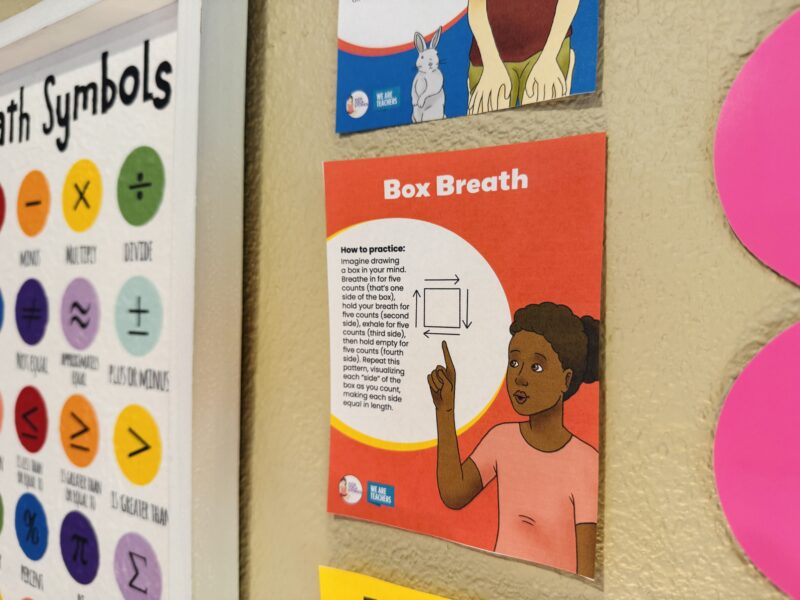
Deep breathing reduces stress and anxiety—it’s an incredible tool for managing emotions at any age. The concepts are simple and can become automatic when you practice them early and often. Check out our collection of five breathing exercises that are perfect for preschool and kindergarten, like Bunny Breathing and Box Breathing. Be sure to print and share our free posters too!
17. Sing feelings songs
Songs can help teach emotional vocabulary in a fun and relatable way. You’ll find all sorts of songs for kids about emotions and feelings on sites like YouTube. Put together a playlist to share with your class with picks like the “Feelings Song” by The Singing Walrus on YouTube
18. Keep a feelings journal
Most preschoolers and kindergartners aren’t able to do a lot of writing on their own, but they can draw pictures to illustrate their feelings each day. Teachers can add a few emotion words to each page for kids not old enough to write on their own yet.
19. Create a cozy calm-down corner

Set aside a separate cozy space where kids can go when they’re having trouble handling big feelings of any kind. Make it comfy and calming with beanbag chairs or a soft rug, and include tools and toys to help kids find their inner calm. Hang a feelings chart, provide stuffed animals for hugs, stock up on fidget toys, and don’t forget noise-cancelling headphones to help them block out distractions.
Learn more: How To Create and Use a Calm-Down Corner
20. Practice daily yoga

Kids are never too young to try some yoga poses! They can help kids find their inner calm when they’re upset or overexcited. Teach and practice a new pose each day during your morning meeting, or use them for brain breaks or transition times.
21. Use a feelings spinner
Hand out white paper plates, and have students draw eight circles representing faces around the edge. Then, they give each face a feeling (happy, sad, angry, tired, surprised, afraid, hungry, excited, calm). Once the faces are complete, create a spinner using a brad and arrow. Students point the arrow at the face that represents how they’re feeling today. This is also a good social-emotional learning activity to do with students who would rather point to how they feel than talk about it.
22. Try emotions charades
Here’s another fun way to use our free printable emotions cards! Kids draw an emotion card from the pile, then act it out for others to guess. For example, if they draw “angry,” they could stomp around with a mean face, pretending to yell. This one is great for encouraging the imagination too!
23. Make calm-down jars

Make these mesmerizing calm-down jars for your classroom using just water, oil, and food coloring. Add glitter for a little extra pizzazz. When students are feeling overwhelmed or upset, give them a few minutes to focus on the jar as they turn it upside down and back. Focusing on the movement and colors will help students calm down so they can get back to work.
Try it: DIY Calm-Down Jars
24. Take a nature walk
Take social-emotional learning activities outside with a nature walk that uses students’ five senses. Explore the changing color of leaves, different leaf shapes, pine cones, and more. Listen for birds and other critters. Lie down on the grass and feel the earth beneath you as you look up at the blue sky. These mindfulness activities remind kids of the emotional importance of getting outside to “touch grass” on a regular basis.
25. Set up sensory stations
Sensory bins or tables engage the senses, giving students something to focus on besides their roiling emotions. Teach students that they can spend time at the sensory station any time they feel overwhelmed and need to calm down. Switch out your stations regularly to stimulate new feelings, physically and emotionally.
Try it: Sensory Table Ideas for Kids
SEL Activities for Social Awareness and Relationship Skills
At this age, kids are just learning how to navigate social relationships and becoming more aware of the differences and similarities between themselves and their peers. SEL activities for preschool and kindergarten emphasize the need for empathy, kindness, and cooperation with those around us. Teachers and parents should model good behaviors, as well as teach them directly and indirectly with social-emotional learning activities like these.
26. Choose your daily greetings

Daily greeting routines build community and confidence. They can also be used as a social-emotional learning check-in. Use this daily greeting printable to give students ideas for how they can greet you. You can use the ideas on the printable or create your own with your class.
27. Draw helping hands
Talk about how our hands can help others. Then, students trace their own hands and reflect on what their helpful hands can do. You can create a class bulletin board using the students’ drawings. Over the next weeks, take photos of students helping and add them to the bulletin board.
28. Plant seeds of kindness
Have students write or draw one kind act they can do today on a paper “seed,” then hang it in a kindness garden bulletin board or place it in jar.
29. Hang leaves on a kindness tree

Draw a large tree trunk on a sheet of chart paper. Then pass out different-colored leaves made from construction paper (or use our printable leaf template linked below) and ask each student to write or draw an act of kindness they can do on their leaf. After they’ve finished, help them tape their leaf to the tree trunk as reminders of how they can show kindness and respect for others. Add more leaves to the tree as you notice students being kind.
30. Play Kindness Bingo
Create bingo cards showing different ways to be kind or show kindness, and use them to give an SEL twist to the classic game. Have students help you brainstorm the various squares on the card and come up with pictures that represent the actions.
31. Hold a compliment circle
Have students sit in a circle with their legs out so that everyone’s feet are in the circle. Ask for a volunteer or start the circle. The first person says a compliment for a peer. The peer says “Thank you!” and pulls their legs in so they are sitting crisscross-applesauce. Then, they give the next compliment. The compliment circle continues until everyone has received a compliment and is sitting crisscross-applesauce.
32. Use conversation starters
Learning to talk to others, especially new people, is vital for developing healthy friendships. Get the conversation started with questions like “What is your favorite thing to eat at lunch?” or “What was the funniest thing that happened to you today?” Pair students up and have them take turns asking the questions and giving answers to start a conversation.
33. Practice sharing with ice cream cones
Sharing is one of those skills that can be really hard for kids to develop. Practice the idea of sharing by making paper ice cream “cones” and passing the “ice cream” (a lightweight ball that will fit in the cone) from one person to another. As students share their ice cream, have them practice saying please and thank you.
34. Teach whole body listening

Teach students what their bodies should look like when they are listening. Use these whole body listening posters to reinforce this skill. Note you can always make accommodations for students since kids with ADHD, autism, and sensory-processing challenges may not be able to perform whole body listening in the same way other students do.
35. Practice listening daily
Learning to listen, not only to themselves but to one another, is a critical skill for preschoolers. Set aside time each day to sit quietly with your students and listen for sounds in and around the classroom for increasing lengths of time. Or ring a chime and ask students to see how long they can hear the sound it makes. Intentional listening exercises like these give kids practice with this sometimes-challenging skill in a low-risk setting.
36. Play listening games
Practice listening skills with a game like Simon Says, Telephone, Freeze Dance, or Musical Chairs. Players must listen closely and pay attention if they want to win!
37. Watch friendship videos
Learning to get along with others takes a lot of practice. A video can be a conversation starter for students or a way to talk about how to handle tough friendship situations.
Try it: Best Friendship Videos for Kids
38. Read poems about friendship
As young children learn about different ways we express ourselves, use poetry to talk about friendship. After you’ve read poems about friendship together, write a class poem or challenge older kindergartners to write their own friendship poems.
Try it: Best Poems About Friendship for Kids
39. Sing along to friendship songs
Listen to friendship songs with your students and talk about the lyrics. What does it mean when Woody sings “you’ve got a friend in me?” or when the Beatles sing they “get by” with a little help from their friends?
Try it: Fantastic Songs About Friendship for Kids
40. Create friend paper dolls
Have students think about what kind of friend they want and want to be by creating friend paper dolls. Draw an outline of a person on paper and give one to each student. Students decorate their “friend” and then share what they included. Does their friend have a pet to take care of together? Does their friend like gymnastics, just like them?
41. Fill buckets with positivity
The book Have You Filled a Bucket Today? has become a hit in preschool and elementary school classrooms, teaching kids how their words and actions affect others. Read this book, then give each student buckets and pom-poms representing positive comments. Encourage students to fill each others’ buckets with kind words and deeds!
Try it: Bucket Filler Activities for Kids
SEL Activities for Responsible Decision-Making
42. Tell social stories

Social stories are simple narratives that teach rules, expected behaviors, and how to handle various situations. For example, you may use a social story with students to teach them what to expect and how to behave during a fire drill. Or you may use a social story with a student who wants to learn how to make a friend or handle a social situation. The goal of social stories is that students learn clear actions they can take to solve common social situations.
43. Let kids work out their own problems
As your students engage in play and collaboration, conflict will occur. When it does, help them solve their problems by observing and modeling rather than solving their problems for them.
Learn more: Ways To Help Kids Solve Their Own Playtime Problems
44. Rehearse with role-play
Role-play is a wonderful way to teach your preschoolers and kindergartners social behaviors, rules, and expectations. Rehearsing these skills in a safe space, with a teacher’s guidance, helps them learn social norms. Pretend how to act in a restaurant, assembly, or in other spaces they’ll need practice with. Or practice how to handle situations that kindergartners will come across, like not wanting to share a toy or asking someone for help.
45. Get a classroom pet
This is definitely a lot of work for teachers, but the benefits for students can be unbelievable. Even students who are uncomfortable around other children can often empathize with animals, helping them develop a better understanding of humans too. When kids help take care of a class pet, they have to make good decisions and demonstrate responsibility too. Not ready for the commitment in your classroom? Consider bringing in your own dog from time to time for students to play with.
Learn more: Best Classroom Pets, According to Teachers
46. Teach coping strategies

In any social situation, conflict will happen. Teach students what to do beforehand with strategies like saying “stop,” ignoring the behavior, walking away, and getting help.
47. Play with dolls
Imaginative play with dolls helps develop social-emotional relationship skills in every child, regardless of gender. Be sure to provide dolls that ensure every student sees themselves represented in your classroom, and include different styles and sizes too. As kids play, praise them for good social skills (“You did a good job helping your doll get dressed”) and guide them to kinder, more responsible behaviors (“How do you think the doll feels when you throw it down and step on it?”).
Learn more: Why Dolls Belong in Kindergarten
48. Play a cooperative board game
When kids play games that require them to work together to win, they build all sorts of SEL skills. They need to make smart decisions and think ahead to plan their strategy. Plus, they need to cooperate and function as a team to decide what to do next. Keep some of our favorites on hand in your classroom for quick and easy SEL activities!
Learn more: Best Cooperative Board Games for the Classroom
SEL Books for Kindergarten and Preschool
Thoughtful book choices turn story time into learning time! Many books for kids are written with social-emotional learning in mind. Look for relatable characters that kids enjoy to help make the messages more meaningful to your audience. Here are some of our top picks for SEL books for preschool and kindergarten.
49. Mindfulness books for kids
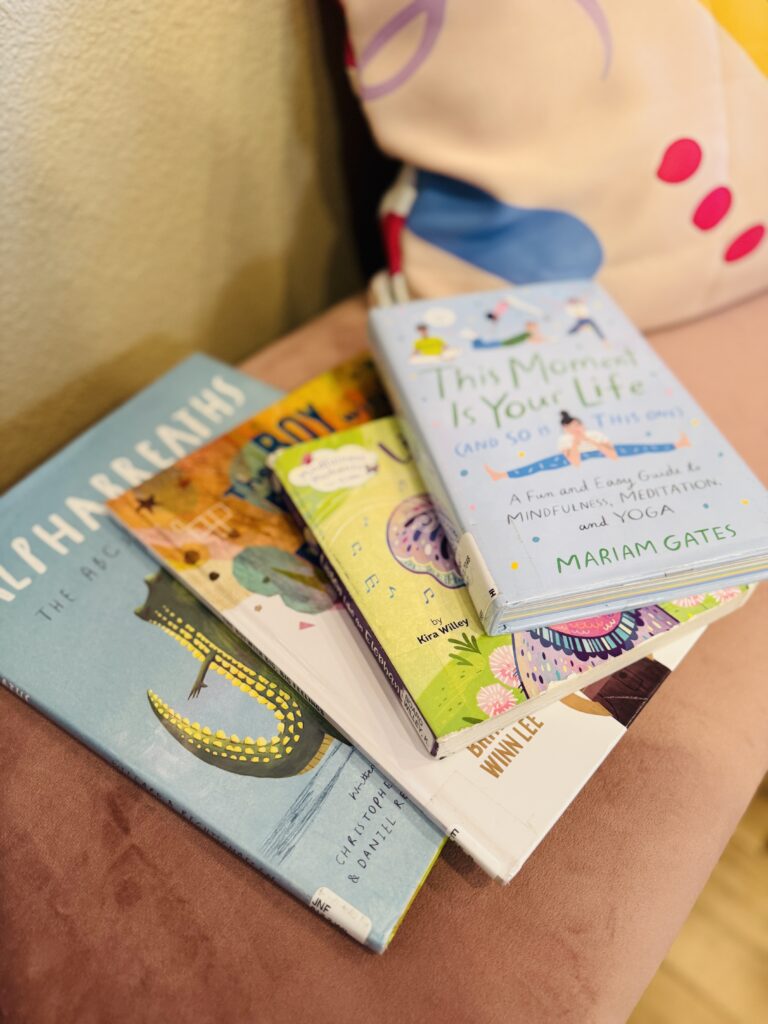
Mindfulness can be an abstract concept. Teach students what mindfulness is and what it looks like in our lives through read-alouds.
Try it: Best Mindfulness Books for Kids
50. Social skills books for kids
There are so many books that teach good social skills, both directly and indirectly.
51. Kindness books for kids
Work kindness into your read-alouds with these selections perfect for preschool and kindergarten.
Try it: Best Kindness Books for Kids
52. Books about teamwork and cooperation
Check out our roundup of books that help kids learn to share, work together, and build strong relationships.
Try it: Best Books About Teamwork and Cooperation
53. Anti-bullying books for kids
Bullying is a serious topic, and one worth addressing early on. Try these books to start a conversation with your students.
54. Growth mindset books for kids
Use these read-alouds to help unleash the “power of yet” with your students!
Try it: Best Growth Mindset Books for Kids
55. Books about anxiety for kids
We all experience anxious moments. Teach kids how to handle them in healthy ways with this collection of books.
Try it: Best Books About Anxiety for Kids





